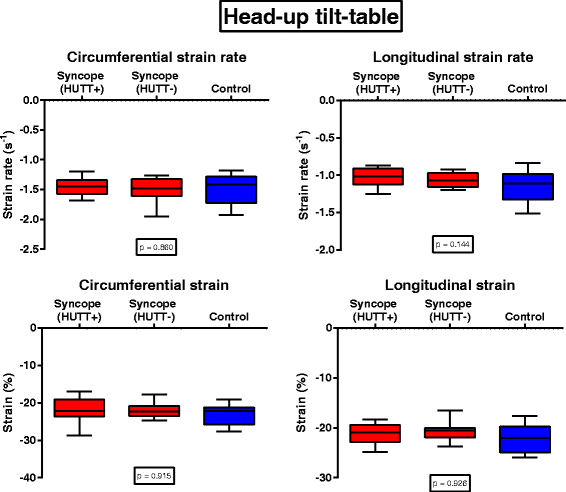Novel functional advanced echocardiography for the assessment of myocardial mechanics in children with neurocardiogenic syncope - a blinded prospective speckle tracking head-up tilt-table challenge study
- PMID: 29739317
- PMCID: PMC5941376
- DOI: 10.1186/s12872-018-0826-0
Novel functional advanced echocardiography for the assessment of myocardial mechanics in children with neurocardiogenic syncope - a blinded prospective speckle tracking head-up tilt-table challenge study
Abstract
Background: Data on left ventricular (LV) function in patients with neurocardiogenic syncope (NS) is conflicting in adults and lacking in children. The aim of this study was to analyze LV myocardial performance in children with NS at rest and during head-up tilt-table (HUTT) testing.
Methods: This is the first study to combine HUTT and speckle-tracking echocardiography (STE) in children with NS. 43 consecutive normotensive pediatric patients with NS (mean age 13.9 ± 2.6 years, 51% female) and 41 sex- and age-matched healthy controls were included in the study. The study groups consisted of 21 patients with a positive HUTT reaction (HUTT+) and 22 with a negative HUTT reaction (HUTT-). STE was used to analyze peak systolic LV myocardial strain and strain rate.
Results: Conventional echocardiographic parameters were similar in all analyzed groups. When compared to healthy controls, children with NS had depressed levels of circumferential strain rate (p = 0.032) and significantly depressed longitudinal strain rate (p < 0.001) at rest. Interestingly, during HUTT testing LV global strain and strain rate were similar in both groups. LV strain rate was lowest in HUTT+ followed by HUTT- and control subjects both at rest and during HUTT.
Conclusions: Resting LV longitudinal strain rate is attenuated in children with NS, especially in those with a positive HUTT response. This is further evidence that NS patients feature altered cardiac mechanics rendering them prone to vasovagal perturbations that can ultimately result in collapse.
Trial registration: Witten/Herdecke University ethics committee clinical study number: UWH-73-2014.
Keywords: Collapse; Functional autonomic response test; LV function; Pediatric echocardiography; Strain rate; Vasovagal syncope.
Conflict of interest statement
Ethics approval and consent to participate
The study was carried out in accordance with the declaration of Helsinki’s ethical principles for medical research involving human subjects and approved by the Witten/Herdecke University ethics committee (
Competing interests
The authors declare that they have no competing interests.
Publisher’s Note
Springer Nature remains neutral with regard to jurisdictional claims in published maps and institutional affiliations.
Figures



References
Publication types
MeSH terms
LinkOut - more resources
Full Text Sources
Other Literature Sources
Medical
Research Materials
Miscellaneous

